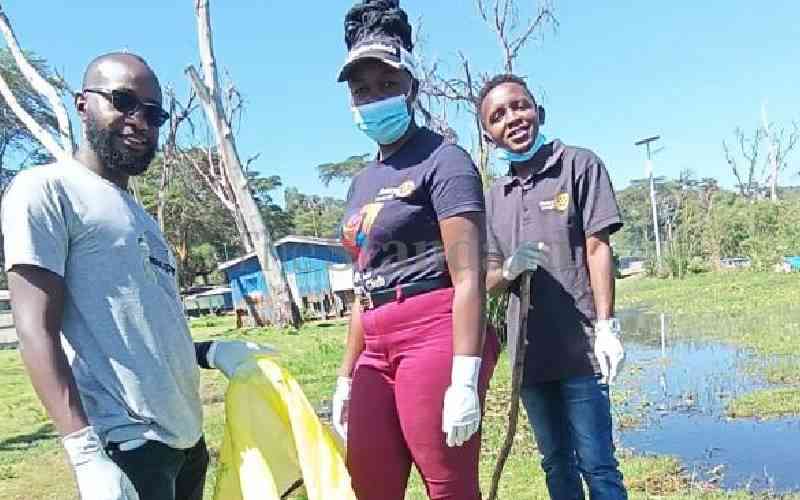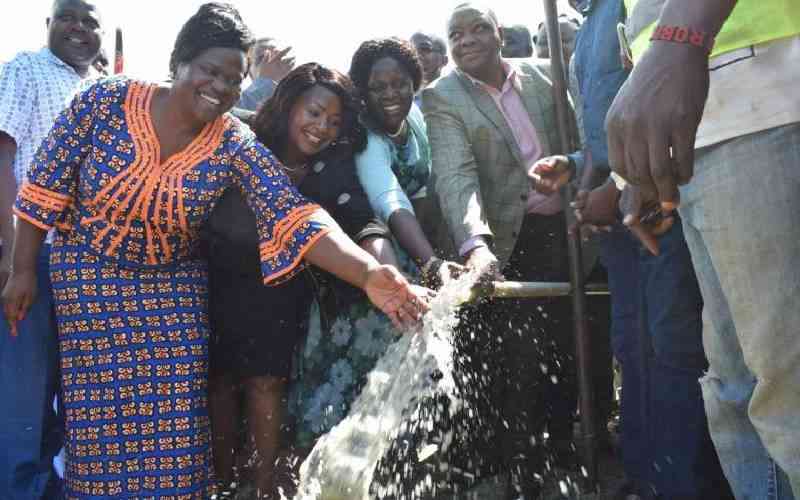
As the afternoon wears on, Nantoiya Parkusat rests after a hard morning’s work in the small farm.
Her home is set on hill overlooking the Ngare Ndare Forest on one end and Lewa Wildlife Conservancy on the other.
Parkusat’s family farm set on one acre has green onions, maize, potatoes and vegetables. There are two oscillating sprinklers on spewing water on the plants. The green crops are common along the hillside in other homes.
“We plant three times a year, because we have water throughout,” she says about onion farming which she, together with her husband Lesaya Parkusat, ventured into after leaving livestock rearing mainly due to incessant cattle rustling.
The water comes from a huge concrete tank set on the hill; this tank supplies over 2,000 people in the area alone and draws its water from a river that flows from the Ngare Ndare Forest, a key catchment area that nourishes the conservancy.
The story was never the same a few years ago. Degradation of the forest was commonplace and locals would venture into the forest to get wood fuel, water and livestock feed. This led to a significant destruction of the important catchment that lies in the East of Meru County. Locals also used furrow irrigation.
Abdi Mohammed, a resident who has seen the changes over the years states that in the 1990s the forest faced extinction mainly from human activity. An intervention had to be found very fast or else, matters would head south for not only the locals but every dependent of the catchment.
“Being a resource that is important for both local communities, livestock and wildlife, something had to be done for the benefit of each,” says Mohammed who is the chair of the Manyagalo Community Development Group.
The wanton destruction was exerting a perilous ripple effect downstream with one of the most affected establishments being the Lewa Conservancy and other ecosystems that depend on the rivers.
Ngare Ndare Forest is an important corridor for wildlife between Mt Kenya ecosystem and the northern rangelands which has a number of conservancies, beginning with Lewa which borders the forest.
This is the corridor that animals use with change in seasons that bring with it availability – or lack – of food to sustain the ecosystem. The forest is an important tourism site where the big five can be sighted as they make their way to and from the mountain forest sanctuary.
The formation of the Ngare Ndare Forest Trust was the turning point in a multi-sectoral initiative by the community, Kenya Forest Service (KFS) and Kenya Wildlife Service (KWS), Lewa Conservancy. Currently, it is supported by Safaricom Foundation, Africa Digna and Northern Rangeland Trust (NRT). The initial formation of the trust was in 1997.
Mohammed adds, “The goal was to restore this forest to its state of the 1950s and communities that border Ngare Ndare were involved.”
These communities were from Manyagalo, Ngare Ndare, Ethi, Bujo, Kisima and Subuiga each of which has a chairperson representing it in the trust.
Stay informed. Subscribe to our newsletter
One of the problems was that locals did not own land near the forest hence no sense of ownership for the natural resources. They had nothing to hold on to until land was donated.
“This changed when land was subdivided among people who mainly worked in Lewa Ranch before it was converted into a conservancy. Lewa played a key role in the subdivision.
To help reduce unsustainable use of water, the conservancy partnered with government to provide water to the locals.
The construction of the tank was one among the community engagements by the conservancy. Mohammed says the move to create a trust and the setting up of the community water tank reduced cases of encroachment.
Actually, the conservancy has so far initiated 13 water projects to provide clean and safe water for people and livestock. According to the Lewa Wildlife Conservancy 2017 Impact Report, the latest water project done in collaboration with the government was at Ntumburi that provides 10,000 people.
The report also lists the community-focused programmes like healthcare, microfinance, youth-empowerment, livestock development and employment opportunities.
In 2017, the conservancy increased its spending on programmes by 33 per cent from the previous about Sh380 million to over half a billion shillings.
Dr Tuqa Jirmo, the chief operating officer at Lewa says that the community is at the centre of conservation efforts because in this way, they get to appreciate why wildlife conservation is crucial and critical.
“Lewa has cultivated a model that can be emulated and replicated all over the country if we need to realize conservation and development goals since in investing back on the local community, they get to appreciate why conservation is important,” says Jirmo.
 The Standard Group Plc is a
multi-media organization with investments in media platforms spanning newspaper
print operations, television, radio broadcasting, digital and online services. The
Standard Group is recognized as a leading multi-media house in Kenya with a key
influence in matters of national and international interest.
The Standard Group Plc is a
multi-media organization with investments in media platforms spanning newspaper
print operations, television, radio broadcasting, digital and online services. The
Standard Group is recognized as a leading multi-media house in Kenya with a key
influence in matters of national and international interest.
 The Standard Group Plc is a
multi-media organization with investments in media platforms spanning newspaper
print operations, television, radio broadcasting, digital and online services. The
Standard Group is recognized as a leading multi-media house in Kenya with a key
influence in matters of national and international interest.
The Standard Group Plc is a
multi-media organization with investments in media platforms spanning newspaper
print operations, television, radio broadcasting, digital and online services. The
Standard Group is recognized as a leading multi-media house in Kenya with a key
influence in matters of national and international interest.










